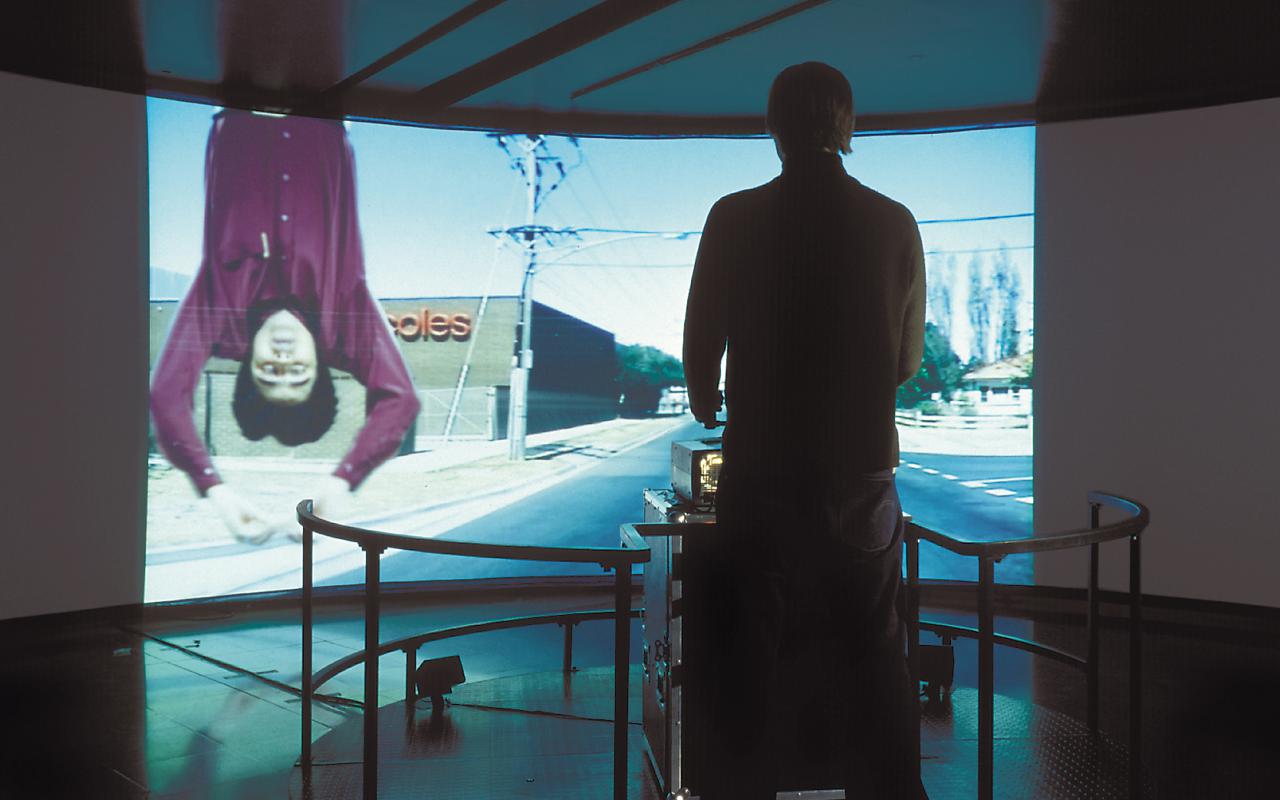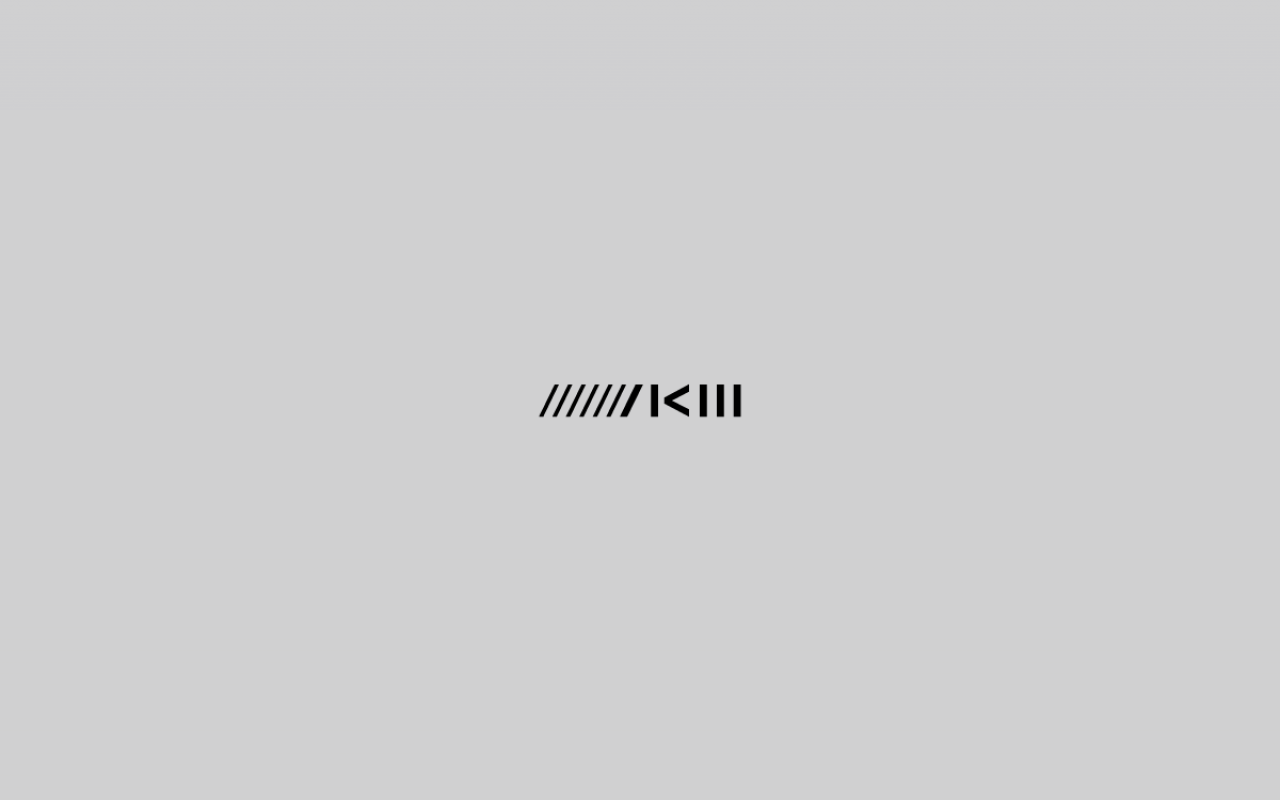
Jeffrey Shaw: »Place-Ruhr«, 2000<br />
Dortmund<br />
<br />
In this work the viewer can explore a three dimensional virtual environment that is constituted by an emblematic constellation of panoramic locations and events. The installation is physically constituted by a rotating platform that allows the viewer to interactively rotate a projected image within a large circular projection screen. It presents a virtual landscape containing eleven photographic cylinders that actualize particular sites in the Ruhr area. The viewer can navigate this three-dimensional space and enter these panoramic cylinders. Once inside the represented imagery becomes a surrounding cinematic performance which fills the projection screen and presents a pre-recorded situation as an immersive event.<br />
<br />
The identity of each of the eleven sites is defined by its environmental scenography, both real and artificial, which are conjoined with a time-based occurence that has been staged there. These events are approximately one minute in duration and repeat themselves continuously in loops. Similarly, the landscaped architecture of eleven cylinders repeats itself infinitely in all directions. The overall ground surface of this landscape is inscribed with a diagram of the cabalistic ëTree of Lifeí, and the eleven Ruhr site cylinders are situated in a figurative relation to this diagram which is coupled to a map of existing underground mining tunnels in the Dortmund area.<br />
<br />
On the platform there is a column with an underwater video camera. This device is the interactive user interface; its buttons and handling allow the viewer to control his movement through the virtual scene as well as cause the rotation of the platform and of the projected image around the circular screen. A small monitor within this housing also shows the ground plan of the virtual environment in relation to the userís location there.<br />
<br />
A microphone on top of this interface camera picks up any sound that the viewer makes, and this causes the release of continuously moving three dimensional words and sentences within the projected scene. Originating in the center of the screen, the physical arrangement of these texts in the virtual environment is determined by the path of the viewer movements while they are being generated. These texts have a temporal five-minute duration; becoming more and more transparent until they disappear they constitute a trace and transitory memory of the viewerís presence there.<br />
<br />
This work is dedicated to the Ruhr valley - to the past present and future transmutation of a geographical and geological patrimony into a profound arena of human exigency.<br />
<br />
<br />
Jeffrey Shaw: »Place-Urbanity«, 2002<br />
Courtesy the Australian Centre for the Moving Image (ACMI), Melbourne<br />
<br />
A psycho-ethnographic portrait of Melbourne<br />
<br />
Melbourne is a notably multicultural city because of the size and diversity of its many immigrant communities. Melbourne also has the reputation of being the comedy capital of Australia. »Place-Urbanity« presents fifteen fully panoramic video recordings of various urban locations in Melbourne that each identify the districts of a specific immigrant and/or ethnic community: Chinese, Macedonian, Greek, Italian, Vietnamese, Turkish, Russian, Jewish, Aboriginal, African, Serbian, Indian, Australian, Egyptian and Lebanese.<br />
<br />
The installation allows the viewer to rotate a projected image within a fully surrounding 9m diameter projection screen. A virtual pscyho-geographic reconstruction of the Melbourne urban landscape presents the fifteen panoramic recordings within a series of architectonic cylinders on whose interior walls these videos are viewable. When exploring each of the panoramic scenes the visitor will find a comedian, hanging upside down, who when coming into view will tell a joke. Each comedian is a member of the particular ethnic community represented in their panorama surroundings, and their jokes reflect critically and humorously their distinctive identities within the Australian social and geographical context.<br />
<br />
Produced with the assistance of Cinemedia's Digital Media Fund ( the Digital Media Fund is funded by Multimedia Victoria as part of the Victorian Government's Connecting Victoria policy, which aims to bring the benefits of technology to all Victorians); the Australian Centre for the Moving Image; ZKM, Centre for Art and Media, Karlsruhe; the Australian Research Council; the Centre for Interactive Cinema Research, College of Fine Arts, the University of New South Wales; The University of Western Sydney; the Australia Council, the Australian Federal Government's Arts Advisory Body.<br />
<br />
Credits for: Jeffrey Shaw: »Place-Ruhr« and »Place-Urbanity« Application software: Adolf Mathias Application hardware: Huib Nelissen 360 degree video production and post-production: Andreas Kiel Production team: Jan Gerigk, Torsten Ziegler, Derek Hauffen, Christina Zartman
- Organization / Institution
- ZKM | Zentrum für Kunst und Medientechnologie
- Sponsors
Cinemedia's Digital Media Fund ; Australian Centre for the Moving Image ; Australian Research Council ; Centre for Interactive Cinema Research ; College of Fine Arts ; University of New South Wales ; University of Western Sydney ; Australia Council ; Australian Federal Government's Arts Advisory Body
